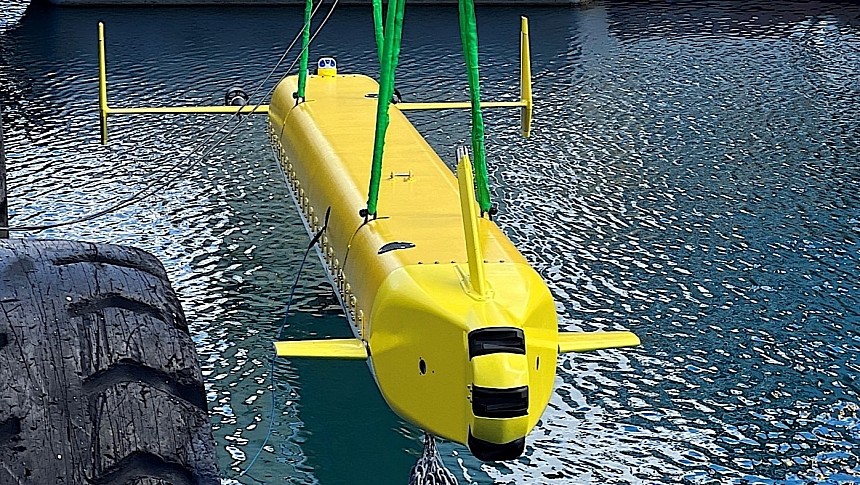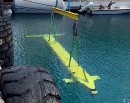As the importance of underwater drones for military operations increases, so does the interest of research agencies and companies in them. Several projects are in the process of being researched, including the very spectacular DARPA-led one called Manta Ray.
We first learned of the project in 2020, when the military research agency announced plans to develop "technologies allowing payload-capable autonomous unmanned underwater vehicles (UUVs) to operate on long-duration, long-range missions in ocean environments."
The name of the drone, Manta Ray, was chosen because its shape resembles that of the cartilaginous fish that lives in tropical and subtropical waters of the planet's ocean. It's also a shape that's supposed to make the drone move with more skill through the water as it pursues its goals.
The general idea behind the project is to come up with a system that can be launched from a host vessel and then go about its business on its own, while needing little to none logistic support or maintenance.
The exact capabilities of the Manta Ray are not known at this point, but we do know two companies are involved in making separate versions, Northrop Grumman and PacMar Technologies.
We got a glimpse at how the project is progressing exactly a year ago, when Northrop Grumman released a video showing a virtual Manta Ray. For all intents and purposes, the shape of the rendered one is roughly the same as the one we're used to from the previous renderings released by DARPA.
Not the same can be said about the prototype shown last week by the agency. That one looks like your average uncrewed sub, a long cylinder with fins to either side, front and rear (check gallery to see what I mean). And to be honest, we're not entirely sure if this is not the shape of the Manta Ray to come.
The drone you see here is a scaled prototype made by the other competitor in the program, PacMar Technologies. It was put in the water at an undisclosed point in the past in Oahu, Hawaii, as a test bed. One technically meant not to test the shape of the final drone or its attributes, but to verify sensors.
However, on top of that we're told the in-water splash test also targeted vehicle hydrodynamic performance and autonomy behaviors of the glider body. And that kind of casts a shadow over what shape the drone will actually take when it's ready.
PacMar will use the data gathered from this test to further advance a full-scale prototype for demonstration at sea. We're not told when that's expected to happen, but given how rival Northrop Grumman is planning such a test for 2024, it'll probably be soon.
It remains to be seen what actual shape the two prototypes will take, and who will win the competition to have it made.
The name of the drone, Manta Ray, was chosen because its shape resembles that of the cartilaginous fish that lives in tropical and subtropical waters of the planet's ocean. It's also a shape that's supposed to make the drone move with more skill through the water as it pursues its goals.
The general idea behind the project is to come up with a system that can be launched from a host vessel and then go about its business on its own, while needing little to none logistic support or maintenance.
The exact capabilities of the Manta Ray are not known at this point, but we do know two companies are involved in making separate versions, Northrop Grumman and PacMar Technologies.
We got a glimpse at how the project is progressing exactly a year ago, when Northrop Grumman released a video showing a virtual Manta Ray. For all intents and purposes, the shape of the rendered one is roughly the same as the one we're used to from the previous renderings released by DARPA.
Not the same can be said about the prototype shown last week by the agency. That one looks like your average uncrewed sub, a long cylinder with fins to either side, front and rear (check gallery to see what I mean). And to be honest, we're not entirely sure if this is not the shape of the Manta Ray to come.
The drone you see here is a scaled prototype made by the other competitor in the program, PacMar Technologies. It was put in the water at an undisclosed point in the past in Oahu, Hawaii, as a test bed. One technically meant not to test the shape of the final drone or its attributes, but to verify sensors.
However, on top of that we're told the in-water splash test also targeted vehicle hydrodynamic performance and autonomy behaviors of the glider body. And that kind of casts a shadow over what shape the drone will actually take when it's ready.
PacMar will use the data gathered from this test to further advance a full-scale prototype for demonstration at sea. We're not told when that's expected to happen, but given how rival Northrop Grumman is planning such a test for 2024, it'll probably be soon.
It remains to be seen what actual shape the two prototypes will take, and who will win the competition to have it made.









